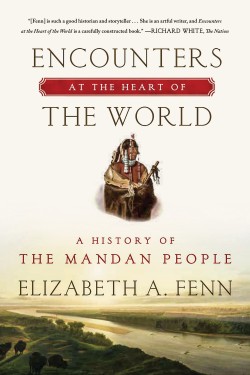Culture | July 29th, 2015
 Author of Pulitzer Prize-winning book to give reading in Fargo
Author of Pulitzer Prize-winning book to give reading in FargoElizabeth A. Fenn, author and professor at the University of Colorado, Boulder, is coming to Zandbroz Variety in downtown Fargo to give a reading and signing of her new book, “Encounters at the Heart of the World: A History of the Mandan People.” The event is scheduled for Monday, Aug. 3, at 7 p.m.
In “Encounters at the Heart of the World,” Fenn pieces together the history and culture of the Mandan people, whose home, “the Heart of the World,” was traditionally centered on the upper Missouri River in North Dakota. By weaving together her own firsthand encounters with the region today, exhaustive archival research and new archaeological findings, Fenn offers an astonishing, eye-opening look at a vibrant culture that was once a vital regional hub of trade and agriculture.
“Encounters,” which was awarded the 2015 Pulitzer Prize for History, is not just an important rephrasing of early American history. It is also an essential read for anyone who calls North Dakota home.
As a primer for the upcoming event, HPR contacted Fenn and asked her a few questions about how “Encounters” came to be.
HPR: How long have you been interested in Mandan history and culture? What initially piqued your interest in upper-Missouri cultures?
Elizabeth Fenn: I learned about the Mandans in the process of researching a huge smallpox epidemic that became the subject of my first book, “Pox Americana: The Great Smallpox Epidemic of 1775-82.” I was stunned to come across such a huge, vibrant, commercial nation that I knew almost nothing about. It made me wonder what early American history would look like if we moved our starting point inland from the Atlantic seaboard. Instead of focusing on Anglo-Americans and their incremental march westward, what if we tell the early American story from the perspective of the heartland and its native peoples? It's a much richer, deeper, longer and more interesting story than the one most of us have been taught.
HPR: When did you first decide to write the history of an entire Native American tribe? How long did that process take?
EF: I began working on “Encounters at the Heart of the World” in 2002. The entire process took twelve years. The book was published in 2014.
HPR: What sort of difficulties did you encounter with your research?
EF: The hardest part was handling the dearth of sources for some periods of time. The result was that I had to be creative and look beyond the written documentary record that most historians rely on for their work.
HPR: In the book, there is quite a bit of emphasis on place and the landscape – the Missouri River plays a central role in Mandan history. Can you describe briefly the importance of the Missouri and the surrounding landscape on Mandan culture? Also, is there anything about the North Dakota landscape that draws you to it?
EF: The confluence of the Heart and Missouri rivers is "the Heart of the World" for the Mandan people. It is where Lone Man and First Creator made medicine pipes together. The landscape along the Missouri is a documentary record in its own right, marking different stories from the Mandan past. These stories teach us about history and about how to act in the world.I love the North Dakota landscape. This is a humbling place. Each time I come here, I am reminded of my own insignificance, of the need to listen and learn from others.
“Encounters at the Heart of the World” reading and book signing
Mon, Aug. 3, 7 p.m.
Zandbroz Variety, 420 Broadway, Fargo
December 18th 2025
October 20th 2025
October 15th 2025
September 16th 2025
July 29th 2025
_(1)__293px-wide.png)

_(1)_(1)_(1)__293px-wide.jpg)
_(1)_(1)_(1)__293px-wide.jpg)

_(1)_(1)_(1)_(1)__293px-wide.jpg)